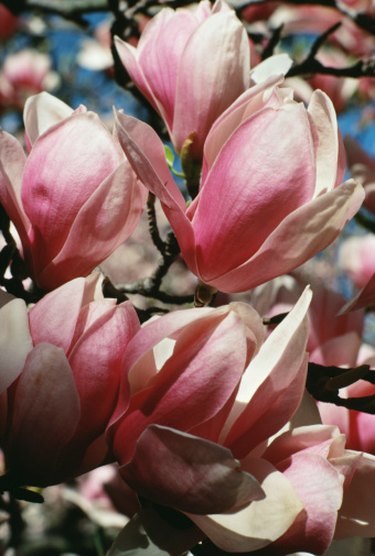
Magnolias are grown for their fragrant flowers and their knobby, red fruit. The flowers, which can be white, pink or purple, range from 3 to 12 inches in diameter, and can have thin or wide petals, depending on the variety. Although the tree has few problems, there are two main reasons why you might find white spots on the branches.
Scale Symptoms
Video of the Day
Magnolia scales are round yellowish or brownish insects that can damage magnolia trees by sucking the fluids out of the plant, slowing growth and weakening the branches until they die. Severe infestations can kill the entire tree. Scales also deposit honeydew on the leaves and branches, which attracts the black sooty mold fungus. The scales collect on the bottom sides of 1- and 2-year-old twigs, sometimes completely crusting over the branches. Branches that are heavily infested look rough and purple but, early in the summer, the females produce a white, waxy coating that covers their bodies, and this makes the trees look like they're covered with white spots.
Video of the Day
Scale Control
The best way to control scales is to remove branches that are heavily infested. Scales can also be controlled by introducing their natural enemies, ladybug beetles. Consult your local extension for information about which species are effective in your area. Nymph populations can be controlled with dormant horticultural oil in the late fall and early spring. Insecticidal soaps or horticultural oil can help control the crawler stage if used in late summer or early fall. Insecticides aren't effective when the scales are protected by their waxy coating.
Mildew Symptoms
Powdery mildew is a fungus infection that causes a white, powdery growth on leaves, shoots, flowers and fruit. Because it can be partially rubbed off the leaves, it's easily misidentified as dust. This disease usually starts as white spots, but as it spreads, the spots run together. Infected leaves may turn yellow and fall from the tree. In addition, new growth may be stunted and distorted. Powdery mildew often appears when the humidity is high or if plants are receiving too much shade.
Mildew Control
Plant magnolia trees in the sun, and water them from overhead, to reduce problems with powdery mildew. Overhead watering is good for controlling powdery mildew because it kills any spores that land in the water. Irrigate your tree in the morning, to give it a chance to dry quickly. This will reduce problems with other fungi. Fungicides can be useful if applied early, before mildew growth becomes widespread. Horticultural oils, neem oil, and jojoba oil are all good eradicants, but they shouldn't be applied if the temperature is over 90 degrees Fahrenheit or if your tree is water-stressed.
- Clemson University Cooperative Extension; Magnolia; Debbie Shaughnessy; May 1999
- Penn State Woody Ornamental Integrated Pest Management: Magnolia Scale Fact Sheet
- University of California Statewide Integrated Pest Management Program; Powdery Mildew on Ornamentals; April 2009
- University of Georgia College of Agriculture and Environmental Science; Growing Southern Magnolia; Gary L. Wade
- Ohioline; Magnolia Scale and its Control; David J. Shetlar
- U. of Illinos Ext. Home, Yard and Garden Pest Newsletter; Magnolia Scale; Phil Nixon; July 31, 2009
- Mississippi Forestry Commission: Southern Magnolia
- Floridata: Magnolia Grandiflora